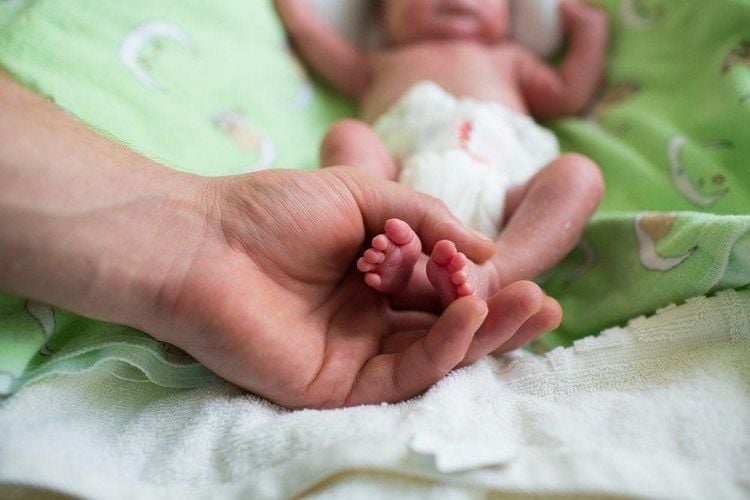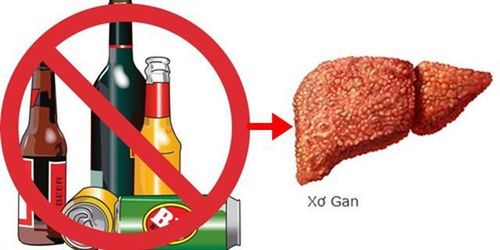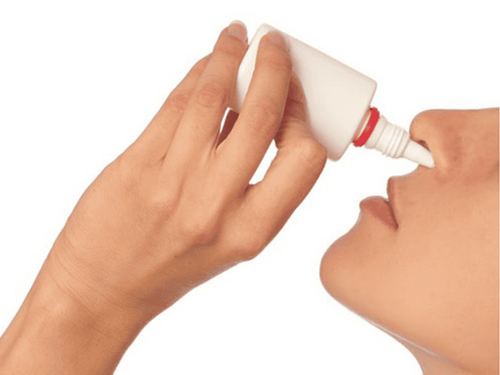This is an automatically translated article.
The article was professionally consulted by Specialist Doctor I Nguyen Thi My Linh - Neonatologist - Pediatrics - Neonatology Department - Vinmec Danang International General Hospital. Specialist Doctor I Nguyen Thi My Linh has 12 years of experience in diagnosing and treating pediatric diseases.Premature babies have not yet perfected the structure and function of their organ systems, often with complex diseases and long-lasting sequelae. In particular, the respiratory ability is still weak, requiring mechanical ventilation with high oxygen concentration for a long time, easily causing bronchopulmonary dysplasia, increasing the risk of death.
1. What is bronchopulmonary dysplasia?
Bronchopulmonary dysplasia, also known as chronic lung disease, is a disease in which the epithelium of the bronchioles are necrotic and keratinized, with reduced surfactant, fibrous proliferation of interstitial tissue, and eventual fibrosis. lung chemistry. Bronchopulmonary dysplasia is a consequence of long-term, high-pressure positive-pressure ventilation with immaturity of lung structure and function and oxygen toxicity.According to the US National Institute of Child Health and Human Development, the definition of this pathology is when the baby still needs oxygen at the time after 36 weeks of gestation (age from the last menstrual period) for premature babies born before 32 weeks of gestation or after about 29 to 55 days of age for premature babies born more than 32 weeks of gestation.
2. What are the dangers of bronchopulmonary dysplasia?
Bronchopulmonary dysplasia causes long-lasting damage to the lung parenchyma, collapses the lung, and limits lung function irreversible. As a result, children need increased oxygen demand and prolonged mechanical ventilation, which in the long run leads to increased pulmonary artery pressure, affects heart function, and causes right heart failure. In addition, ventilator dependence increases the rate of infection, worsens the disease, and increases the risk of death.
3. How to diagnose bronchopulmonary dysplasia?
Bronchopulmonary dysplasia is common in premature infants, especially when there is respiratory failure after birth requiring respiratory support with positive pressure via CPAP, mechanical ventilation with high pressure or high oxygen concentration.At the same time, a prerequisite sign of bronchopulmonary dysplasia is that the child is oxygen dependent over time. Specifically, if a baby is born less than 32 weeks premature and still needs oxygen until they are more than 36 weeks old, if a baby is born prematurely but after 32 weeks still continues to breathe oxygen until they are 29 to 55 days old.
Vinmec International General Hospital is applying CPAP breathing technique for children with respiratory failure. This technique has the following advantages:
Over 95% success rate. Non-invasive to the patient's body. Reduce mortality. Reduce the rate of intubation for patients. The patient recovered quickly. Patient safety. In addition, the child also showed respiratory distress with a breathing rate of more than 60 or less than 30 breaths per minute, a pause in breathing for more than 20 seconds or less than 20 seconds with a heart rate of less than 100 times per minute, and a heart rate of less than 100 breaths per minute. Breathing in and out of the nose, observing respiratory muscle contraction, breathing hard. The child's lips and mucous membranes are cyanotic and SpO2 is reduced by less than 85% if oxygen is not given. Auscultation of the lungs may have moist rales, scattered rales on both sides of the lung.
Subclinical diagnoses:
Blood tests show a decrease in oxygen concentration, an increase in oxygen pressure difference in the alveoli compared to the arteries. X-ray film shows bronchopneumonia, an enlarged lung with many areas of increased light and air retention. Echocardiography is also needed to rule out congenital heart defects and also patent ductus arteriosus.
4. How to treat and prevent bronchopulmonary dysplasia?
The treatment of bronchopulmonary dysplasia in all children is always continued oxygen therapy or mechanical ventilation in parallel with blood oxygen monitoring or indirectly through peripheral blood oxygen saturation. However, the oxygen supply needs to be calculated at the lowest concentration so that the SaO2 is at 90-95%. It is advisable to choose a method of oxygen breathing through the cannula, gradually reducing the flow and gradually switching to intermittent oxygen before completely stopping oxygen breathing. If the child is still on mechanical ventilation, it is necessary to avoid causing hyperventilation by reducing the airway pressure to the lowest level, just keep the PaCO2 at 45-55 mmHg and the SaO2 between 90-95%.Besides, children must also be provided with adequate nutrition to ensure proper development as well as increase respiratory work. At the same time, children also need to be vaccinated according to the same schedule as normal children, to strengthen the immune system.
In some cases, the child may be prescribed additional diuretics, bronchodilators, corticosteroids or antibiotics if there is an infection.
Regarding the prevention of bronchopulmonary dysplasia, the core is to limit the occurrence of preterm labor. If this process cannot be delayed, corticosteroid injections should be given to the mother to accelerate fetal lung maturation. After birth, the baby needs to be restricted from using too much high-dose oxygen and on mechanical ventilation, optimizing the oxygen concentration in the inhaled air but the blood oxygen concentration still reaching the target. Especially for premature babies under 28 weeks of age, it is necessary to use surfactant immediately in the delivery room to avoid ventilator dependence and early weaning. When the child is fine and is released from work, the family needs to be instructed on how to take care of the child at home, the signs to observe, and schedule regular check-ups to monitor breathing and growth over a long period of 1-2 years. there.
Surfactant pumping would be difficult to achieve if the overall standard of care was not of high quality. Vinmec International General Hospital has met strict criteria to apply Surfactant Pump Therapy in the treatment of respiratory failure in infants, including a full range of supportive facilities and a team of doctors to perform. proficient in techniques.
Means of performance:
Heart rate monitor, SpO2. Ventilator (Model: Carescape R860 - Series: CBRW00234, Manufacturer: GE Healthcare No. - USA) 7-parameter monitor (Model: B40i, Manufacturer: GE Healthcare - Finland) Arterial blood pressure measuring instrument (if any). Blood gas analyzer. Bedside X-ray equipment (if any). Vinmec International General Hospital has met strict criteria to apply Surfactant Pump Therapy in the treatment of respiratory failure in infants, including full coverage. supporting facilities and a team of doctors who are proficient in the techniques.
5. Treatment of bronchopulmonary dysplasia with stem cells at Vinmec Times City
In addition to the above, stem cell transplantation has been shown to be effective in the treatment of bronchopulmonary dysplasia. At Vinmec Times City, the only hospital in the North that has performed this technique with a success rate of 80%.This is an advanced technique that can definitively treat severe pulmonary fibrosis in premature babies. Transplanted stem cells are pluripotent cells, helping the fibrosis of the lungs to mature well, increasing the chances of cure and healthy living for premature babies with pulmonary fibrosis complications, gradually reducing the time of dependence on machines, faster quickly return the child to a normal life.
Modern equipment system to support the treatment process, Labo stem cell bank, extraction, culture, high technology. Experienced Doctor: Doctor Tran Lien Anh and Nursing Team have in-depth knowledge and responsibility. Stem Cell Research Institute & Gene Technology: high technical level, capable of culturing stem cells.
Bronchopulmonary dysplasia is an unavoidable lung injury in premature infants if respiratory support is required. However, thanks to medical achievements, especially stem cell transplantation, this disease is no longer a long-term obsession. Vinmec Medical System has gradually applied and succeeded in not only nurturing premature babies but also preserving the child's respiratory function.
As a key area of Vinmec Health system, Pediatrics Department always brings satisfaction to customers and is highly appreciated by industry experts with:
Gathering a team of top doctors and nurses in Pediatrics : Including leading experts with high professional qualifications (professor, associate professor, doctorate, master), rich experience, worked in big hospitals such as Bach Mai, 108.. Doctors All doctors are well-trained, professional, conscientious, knowledgeable about young psychology. In addition to domestic pediatric specialists, the Department of Pediatrics also has the participation of foreign experts (Japan, Singapore, Australia, USA) who are always pioneers in applying the latest and most effective treatment regimens. . Comprehensive services: In the field of Pediatrics, Vinmec provides a series of continuous medical examination and treatment services from Newborn to Pediatric and Vaccine,... according to international standards to help parents take care of their baby's health from birth to childhood. from birth to adulthood Specialized techniques: Vinmec has successfully deployed many specialized techniques to make the treatment of difficult diseases in Pediatrics more effective: neurosurgery - skull surgery, stem cell transplantation. blood in cancer treatment. Professional care: In addition to understanding children's psychology, Vinmec also pays special attention to the children's play space, helping them to have fun and get used to the hospital's environment, cooperate in treatment, improve the efficiency of medical treatment.
Please dial HOTLINE for more information or register for an appointment HERE. Download MyVinmec app to make appointments faster and to manage your bookings easily.














